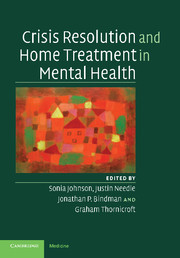Book contents
- Frontmatter
- Contents
- List of contributors
- Foreword
- Acknowledgements
- Section 1 Introduction and concepts
- Section 2 The evidence
- Section 3 Current practice
- 6 Crisis resolution teams: rationale and core model
- 7 The crisis resolution team within the community service system
- 8 Assessment of crises
- 9 Assessment and management of risk
- 10 Symptom management
- 11 Practical psychosocial interventions
- 12 Working with families and social networks
- 13 Strategies for promoting engagement and treatment adherence
- 14 Mixed blessings: service user experience of crisis teams
- 15 Early discharge and joint working between crisis teams and hospital services
- 16 Working with repeat users of crisis resolution services
- 17 Responding to diversity in home treatment
- 18 Coercion and compulsion in crisis resolution teams
- Section 4 Variations and enhancements
- Section 5 Developing a local service
- Index
- References
9 - Assessment and management of risk
from Section 3 - Current practice
Published online by Cambridge University Press: 13 August 2009
- Frontmatter
- Contents
- List of contributors
- Foreword
- Acknowledgements
- Section 1 Introduction and concepts
- Section 2 The evidence
- Section 3 Current practice
- 6 Crisis resolution teams: rationale and core model
- 7 The crisis resolution team within the community service system
- 8 Assessment of crises
- 9 Assessment and management of risk
- 10 Symptom management
- 11 Practical psychosocial interventions
- 12 Working with families and social networks
- 13 Strategies for promoting engagement and treatment adherence
- 14 Mixed blessings: service user experience of crisis teams
- 15 Early discharge and joint working between crisis teams and hospital services
- 16 Working with repeat users of crisis resolution services
- 17 Responding to diversity in home treatment
- 18 Coercion and compulsion in crisis resolution teams
- Section 4 Variations and enhancements
- Section 5 Developing a local service
- Index
- References
Summary
The assessment and management of risk is central to mental health practice. This is true in all areas, but especially so in acute settings where risk to self or others is a common concern. The role of crisis resolution teams (CRTs) in England is to assess individuals in a crisis situation and offer home treatment as an alternative to hospital admission where possible. When home treatment is contemplated, risks of suicide, aggression, severe self-neglect and reckless behaviour need to be carefully assessed and decisions made about whether home treatment is likely to be safe. Strategies for monitoring and minimising risk in community settings need to be put in place to enable safe, but responsive, care to be provided. This chapter summarises research on risk in home treatment services and provides guidelines for assessing, monitoring and managing risk to service users, carers, professionals and the community.
Evidence
The CRTs act as gatekeepers to inpatient services (Department of Health, 2002) and hence work with individuals who, by definition, are potentially in need of high levels of support and care and are likely to present high levels of risk to themselves or, more rarely, to others. There is no evidence to date of increased risk of suicide or violence associated with the use of crisis services as opposed to more traditional approaches such as hospital admission.
- Type
- Chapter
- Information
- Crisis Resolution and Home Treatment in Mental Health , pp. 111 - 120Publisher: Cambridge University PressPrint publication year: 2008

